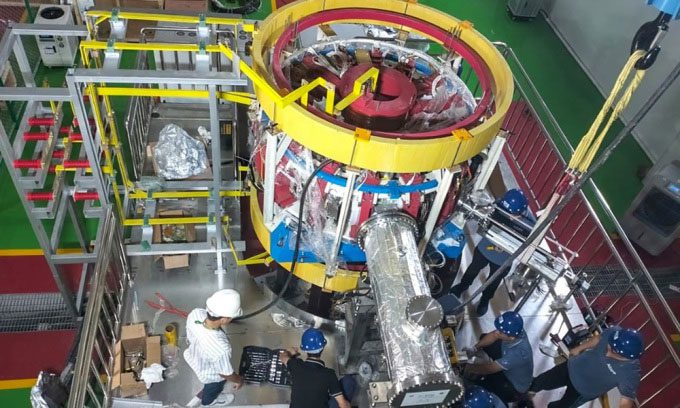Thailand’s Tokamak-1 Fusion Reactor, a collaboration between Thailand and China, began operations on July 25.
Tokamak reactors are often referred to as “artificial suns” due to their ability to mimic the nuclear fusion processes occurring within the sun. The Tokamak-1 reactor in Thailand represents a joint effort between the Thailand Institute of Nuclear Technology and the Institute of Plasma Physics under the Chinese Academy of Sciences. The reactor’s commissioning on July 25 marks a significant milestone in sustainable energy research and the scientific cooperation between the two countries.

Chinese and Thai scientists collaborate on the installation of the Thailand Tokamak-1 reactor. (Photo: SCMP).
This is the first tokamak reactor built by a member of the Association of Southeast Asian Nations (ASEAN). Thailand also plans to design and manufacture its own tokamak reactor for domestic use within the next decade, aiming to become the hub for fusion technology development in Southeast Asia.
Fusion energy is considered the “ultimate energy” for a carbon-neutral future because its production process does not emit greenhouse gases or nuclear waste. The primary byproduct is helium, an inert and non-toxic gas.
Scientists have been researching fusion for decades to find sustainable and cost-effective ways to meet the world’s energy demands. Their goal is to create fusion devices that replicate the fusion reactions of the sun and other stars.
Fusion reactions power the sun. In these reactions, hydrogen nuclei collide and fuse into heavier helium atoms, releasing vast amounts of energy. Fusion occurs in a state of matter known as plasma, which is filled with hot, charged ions at temperatures around 10 million degrees Celsius, according to the International Atomic Energy Agency (IAEA).
Thailand’s Tokamak-1 is an upgrade of the HT-6M, a tokamak reactor developed by the Chinese Institute of Plasma Physics in 1984. This device officially ceased operations in 2002 after 18 years of function. In 2017, the Chinese Institute of Plasma Physics signed a cooperation agreement with the Thailand Institute of Nuclear Technology and announced the donation of the tokamak to Thailand. The institute also assisted Thailand in the installation and operation of the reactor, along with providing training for specialists in the field of fusion energy research and development.
The tokamak reactor passed several tests and was transferred to the Thailand Institute of Nuclear Technology in December 2022. The entire machine consists of 462 main components, weighing over 84 tons. The first successful test of the device took place on April 21, according to Nopporn Poolyarat, head of the fusion and plasma department at the Thailand Institute of Nuclear Technology.


















































